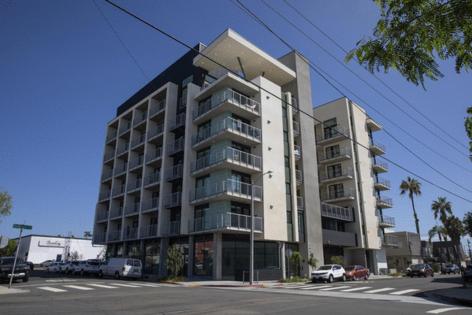San Diego OK'd more new homes in 2023 than any year in decades
Published in Home and Consumer News
SAN DIEGO — San Diego saw a dramatic surge in homes approved for construction during 2023, nearly twice as many as were approved the year prior and the highest number in a single year since at least 2005.
City planning officials, who said it’s likely this was the most homes approved in a single year since the 1980s, credited the surge to a variety of developer incentives spearheaded by Mayor Todd Gloria in recent years.
More than 86 percent of the new units are near transit, which could help the city meet its climate change goals. But officials said not enough are in high-resource areas with good jobs and schools.
The surge went beyond approvals for market-rate homes, which rose by 51% year over year. Approvals of rent-restricted homes for low-income residents were up eightfold and those for very low-income residents more than doubled.
Despite the surge, San Diego remains significantly below pace for meeting its state housing goals, which require the city to approve 108,036 new housing units between 2020 and 2029.
The 9,693 homes approved last year brings the city’s four-year total to 25,692. That means San Diego must approve 82,344 more homes by 2029 — which averages out to nearly 16,500 a year during each of the next five years.
And the gap is even wider on homes for low-income and very low-income residents, where the city has approved only 4,594 of the 44,880 required by the state during this housing cycle.
City officials said the surge is still good news, noting that San Diego approved 70 homes per 10,000 residents in 2023 — far more than Los Angeles at 49 per 10,000 and San Francisco at 38 per 10,000.
“It was a big year,” said Heidi Vonblum, the city’s planning director. “We have been trending at 5,000 permits per year, and this last year was almost 9,700.”
The new data is part of an annual state-mandated report on housing that city officials have produced each year since 2018. The 60-page report was presented Thursday to the City Council’s Land Use and Housing Committee.
The report says a key to the 2023 surge in approvals came from the backyard apartments that the city calls accessory dwelling units.
More than 1,900 ADUs were approved in 2023 — the most within a year in city history and nearly triple the 658 approved in 2022.
The neighborhoods with the most new ADUs approved last year were Clairemont Mesa with 188, North Park with 156 and City Heights with 137.
San Diego has some of the loosest ADU regulations in the state. That has drawn the ire of some critics who predict ADUs will worsen parking scarcity in many neighborhoods.
Two incentive programs played a key role in the broader 2023 approvals surge, city officials said.
The number of homes approved under the Complete Communities incentive — which lets developers build many more units than the underlining zoning would otherwise allow — skyrocketed from 170 in 2022 to more than 1,300 last year.
Neighborhoods with the most approved Complete Communities units last year include North Park, the College Area and Uptown, which includes Hillcrest and Bankers Hill.
Some critics say Complete Communities is overly generous to developers.
The number of units approved under the city’s density bonus program, which also allows more units than a property’s zoning otherwise would, nearly tripled from 1,291 in 2022 to 3,530 in 2023. Downtown, North Park and Otay Mesa led the way with density bonus units.
A growing share of the new homes approved are near transit, too — 86 percent of those approved during 2021, 2022 and 2023, and 88 percent of rent-restricted units in those years.
City officials said that shows developers are embracing new incentive programs, which aim to steer new housing near transit to avoid sprawl and to fight climate change.
But San Diego is falling short on a goal of steering more housing into what it calls high-resource areas, which make up about 69 percent of the city.
The new report shows that only 27 percent of the new housing units approved during the last three years have been in high-resource areas. About 35 percent of the new units are in areas designated low-resource.
Another concern is the size of the homes approved in 2023. Nearly 60 percent are studios or one-bedrooms, while less than 16 percent have three or more bedrooms. City officials said that leaves many young families struggling to find affordable housing.
Only 576 of the 9,693 homes approved last year are single-family homes — less than 6 percent.
The city’s independent budget analyst criticized the report for not including data on the city’s inclusionary housing program, which requires developers to include some subsidized units for low-income residents in their projects.
The IBA said it would be particularly worthwhile to track how many developers build the subsidized units on-site, how many build at an alternate site and how many pay a city fee instead.
Planning officials promised to track such data and include it in the next annual housing report.
Councilmember Joe LaCava said the surge in approved housing units shows the home-building industry is starting to embrace the wide variety of incentive programs San Diego has approved.
Councilmember Stephen Whitburn said he’s optimistic that approving so many new housing units can slow rent increases in San Diego.
_____
©2024 The San Diego Union-Tribune. Visit sandiegouniontribune.com. Distributed by Tribune Content Agency, LLC.








Comments